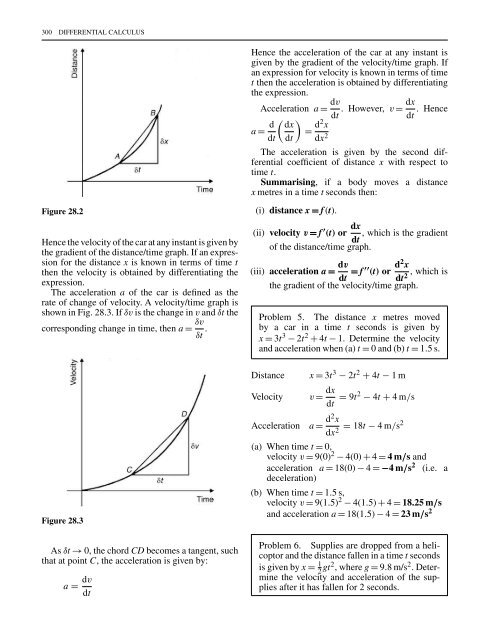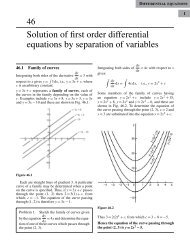differentiation
Create successful ePaper yourself
Turn your PDF publications into a flip-book with our unique Google optimized e-Paper software.
300 DIFFERENTIAL CALCULUS<br />
Figure 28.2<br />
Hence the velocity of the car at any instant is given by<br />
the gradient of the distance/time graph. If an expression<br />
for the distance x is known in terms of time t<br />
then the velocity is obtained by differentiating the<br />
expression.<br />
The acceleration a of the car is defined as the<br />
rate of change of velocity. A velocity/time graph is<br />
shown in Fig. 28.3. If δv is the change in v and δt the<br />
corresponding change in time, then a = δv<br />
δt .<br />
Figure 28.3<br />
As δt → 0, the chord CD becomes a tangent, such<br />
that at point C, the acceleration is given by:<br />
a = dv<br />
dt<br />
Hence the acceleration of the car at any instant is<br />
given by the gradient of the velocity/time graph. If<br />
an expression for velocity is known in terms of time<br />
t then the acceleration is obtained by differentiating<br />
the expression.<br />
Acceleration a = dv<br />
dx<br />
. However, v =<br />
) dt dt . Hence<br />
a = d dt<br />
( dx<br />
dt<br />
= d2 x<br />
dx 2<br />
The acceleration is given by the second differential<br />
coefficient of distance x with respect to<br />
time t.<br />
Summarising, if a body moves a distance<br />
x metres in a time t seconds then:<br />
(i) distance x = f (t).<br />
(ii) velocity v = f ′ (t) or dx , which is the gradient<br />
dt<br />
of the distance/time graph.<br />
(iii) acceleration a = dv<br />
dt = f ′′ (t) or d2 x<br />
, which is<br />
dt2 the gradient of the velocity/time graph.<br />
Problem 5. The distance x metres moved<br />
by a car in a time t seconds is given by<br />
x = 3t 3 − 2t 2 + 4t − 1. Determine the velocity<br />
and acceleration when (a) t = 0 and (b) t = 1.5s.<br />
Distance<br />
Velocity<br />
x = 3t 3 − 2t 2 + 4t − 1m<br />
v = dx<br />
dt = 9t2 − 4t + 4m/s<br />
Acceleration a = d2 x<br />
= 18t − 4m/s2<br />
dx2 (a) When time t = 0,<br />
velocity v = 9(0) 2 − 4(0) + 4 = 4m/s and<br />
acceleration a = 18(0) − 4 = −4m/s 2 (i.e. a<br />
deceleration)<br />
(b) When time t = 1.5s,<br />
velocity v = 9(1.5) 2 − 4(1.5) + 4 = 18.25 m/s<br />
and acceleration a = 18(1.5) − 4 = 23 m/s 2<br />
Problem 6. Supplies are dropped from a helicoptor<br />
and the distance fallen in a time t seconds<br />
is given by x =<br />
2 1 gt2 , where g = 9.8 m/s 2 . Determine<br />
the velocity and acceleration of the supplies<br />
after it has fallen for 2 seconds.










